
- Selenium - Home
- Selenium - Overview
- Selenium - Components
- Selenium - Automation Testing
- Selenium - Environment Setup
- Selenium - Remote Control
- Selenium - IDE Introduction
- Selenium - Features
- Selenium - Limitations
- Selenium - Installation
- Selenium - Creating Tests
- Selenium - Creating Script
- Selenium - Control Flow
- Selenium - Store Variables
- Selenium - Alerts & Popups
- Selenium - Selenese Commands
- Selenium - Actions Commands
- Selenium - Accessors Commands
- Selenium - Assertions Commands
- Selenium - Assert/Verify Methods
- Selenium - Locating Strategies
- Selenium - Script Debugging
- Selenium - Verification Points
- Selenium - Pattern Matching
- Selenium - JSON Data File
- Selenium - Browser Execution
- Selenium - User Extensions
- Selenium - Code Export
- Selenium - Emitting Code
- Selenium - JavaScript Functions
- Selenium - Plugins
- Selenium WebDriver Tutorial
- Selenium - Introduction
- Selenium WebDriver vs RC
- Selenium - Installation
- Selenium - First Test Script
- Selenium - Driver Sessions
- Selenium - Browser Options
- Selenium - Chrome Options
- Selenium - Edge Options
- Selenium - Firefox Options
- Selenium - Safari Options
- Selenium - Double Click
- Selenium - Right Click
- HTML Report in Python
- Handling Edit Boxes
- Selenium - Single Elements
- Selenium - Multiple Elements
- Selenium Web Elements
- Selenium - File Upload
- Selenium - Locator Strategies
- Selenium - Relative Locators
- Selenium - Finders
- Selenium - Find All Links
- Selenium - User Interactions
- Selenium - WebElement Commands
- Selenium - Browser Interactions
- Selenium - Browser Commands
- Selenium - Browser Navigation
- Selenium - Alerts & Popups
- Selenium - Handling Forms
- Selenium - Windows and Tabs
- Selenium - Handling Links
- Selenium - Input Boxes
- Selenium - Radio Button
- Selenium - Checkboxes
- Selenium - Dropdown Box
- Selenium - Handling IFrames
- Selenium - Handling Cookies
- Selenium - Date Time Picker
- Selenium - Dynamic Web Tables
- Selenium - Actions Class
- Selenium - Action Class
- Selenium - Keyboard Events
- Selenium - Key Up/Down
- Selenium - Copy and Paste
- Selenium - Handle Special Keys
- Selenium - Mouse Events
- Selenium - Drag and Drop
- Selenium - Pen Events
- Selenium - Scroll Operations
- Selenium - Waiting Strategies
- Selenium - Explicit/Implicit Wait
- Selenium - Support Features
- Selenium - Multi Select
- Selenium - Wait Support
- Selenium - Select Support
- Selenium - Color Support
- Selenium - ThreadGuard
- Selenium - Errors & Logging
- Selenium - Exception Handling
- Selenium - Miscellaneous
- Selenium - Handling Ajax Calls
- Selenium - JSON Data File
- Selenium - CSV Data File
- Selenium - Excel Data File
- Selenium - Cross Browser Testing
- Selenium - Multi Browser Testing
- Selenium - Multi Windows Testing
- Selenium - JavaScript Executor
- Selenium - Headless Execution
- Selenium - Capture Screenshots
- Selenium - Capture Videos
- Selenium - Page Object Model
- Selenium - Page Factory
- Selenium - Record & Playback
- Selenium - Frameworks
- Selenium - Browsing Context
- Selenium - DevTools
- Selenium Grid Tutorial
- Selenium - Overview
- Selenium - Architecture
- Selenium - Components
- Selenium - Configuration
- Selenium - Create Test Script
- Selenium - Test Execution
- Selenium - Endpoints
- Selenium - Customizing a Node
- Selenium Reporting Tools
- Selenium - Reporting Tools
- Selenium - TestNG
- Selenium - JUnit
- Selenium - Allure
- Selenium & Other Technologies
- Selenium - Java Tutorial
- Selenium - Python Tutorial
- Selenium - C# Tutorial
- Selenium - Javascript Tutorial
- Selenium - Kotlin Tutorial
- Selenium - Ruby Tutorial
- Selenium - Maven & Jenkins
- Selenium - LogExpert Logging
- Selenium - Log4j Logging
- Selenium - Robot Framework
- Selenium - Github Tutorial
- Selenium - IntelliJ
- Selenium - XPath
- Selenium Miscellaneous Concepts
- Selenium - IE Driver
- Selenium - Automation Frameworks
- Selenium - Keyword Driven Framework
- Selenium - Data Driven Framework
- Selenium - Hybrid Driven Framework
- Selenium - SSL Certificate Error
- Selenium - Alternatives
Selenium IDE - Plugins
The functionalities of Selenium IDE can be expanded further by incorporating more commands and locators. This helps to improve the features of Selenium IDE. There are innumerable number of plugins available in Selenium IDE, and some of the most popular ones are listed below −
- Blazemaster Chrome Extension − It is used to perform load testing in Selenium IDE.
- Applitools for Selenium IDE − It is used to perform visual testing in Selenium IDE.
- Chropath − It is a Chrome plugin helpful in identifying the xpath and css locators for web elements.
- Ranorex Selocity − It is used in identifying the xpath and css locators for web elements.
- Katalon Recorder − It is used in identifying the web elements and recording the actions performed on them.
- Page Modeller − It is used in creating the automation tests on multiple languages.
How to Use Plugins in Selenium IDE?
Let us see how to use the plugin Applitools for Selenium IDE along with the Selenium IDE. This would help us to perform visual testing in Selenium IDE. The visual testing is helpful in validating if the application under test has the correct GUI for the end users. The most common example of Visual testing is verifying the logo, color of web elements, font and font size of text, overlapping text, and so on.
Selenium IDE is only capable of Functional testing and can not perform the Visual testing by default. The Applitools for Selenium IDE plugins on top of Selenium IDE is used to perform automation on both the visual testing and functional testing.
The steps to use plugin along with the Selenium IDE are listed below −
Step 1 − Execute the Steps 1 to 4 as described in the link Selenium IDE Store Variables
Step 2 − Install the plugin Applitools for Selenium IDE from the webstore as shown in the below image, then click on the Add to Chrome button.
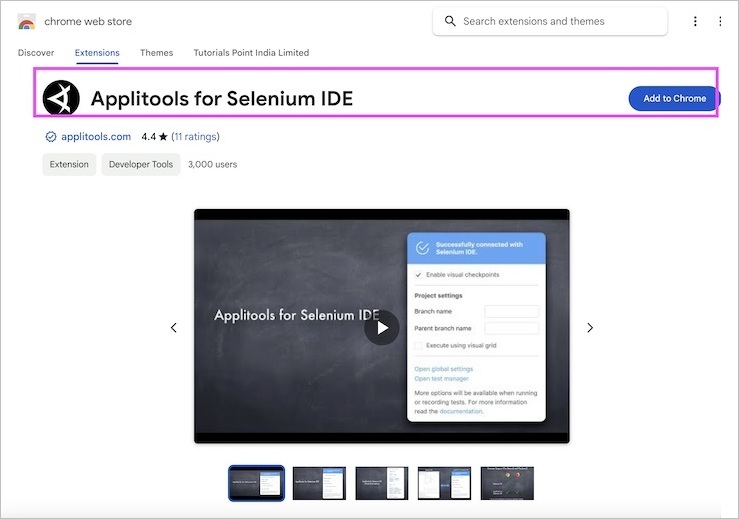
Step 3 − Click on the Add extension button on the pop-up.
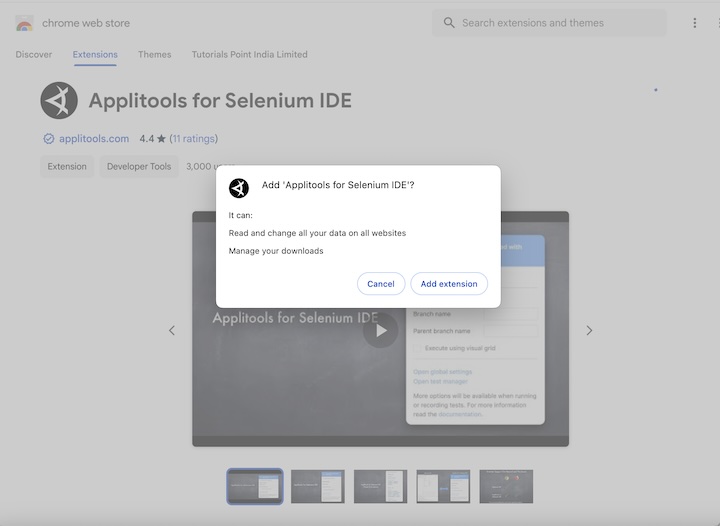
Step 4 − It is recommended that we restart the browser after Step 4. Then the Applitools for Selenium IDE icon would appear on the right upper corner of the browser. Click on it to launch the Applitools for Selenium IDE extension. Then click on the Sign up for a free account link to obtain the API KEY.
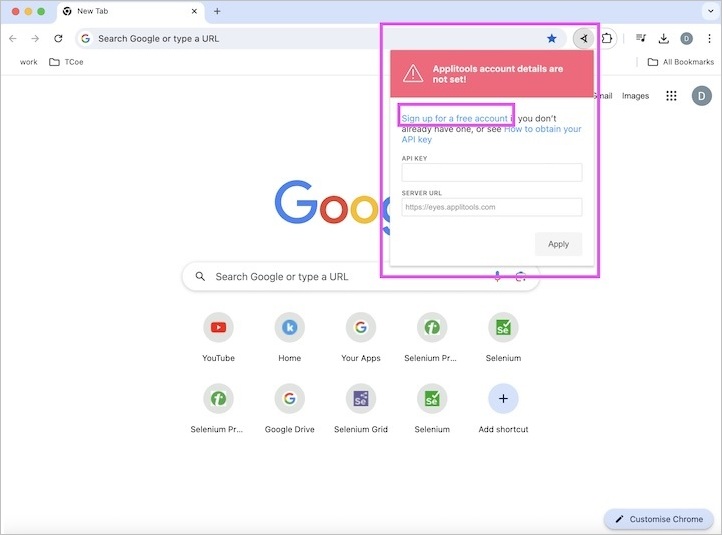
Step 5 − Create an account in the Applitools and click on Sign in.
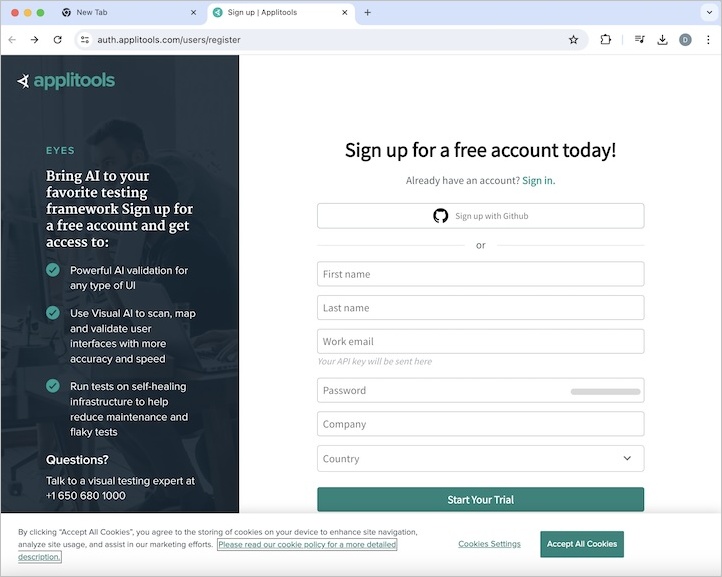
Step 6 − Navigate to the below link and sign in with the credentials set up in the Step 5 −
https://auth.applitools.com/users/login.
Step 7 − Click on the My API key link and copy the API Key.
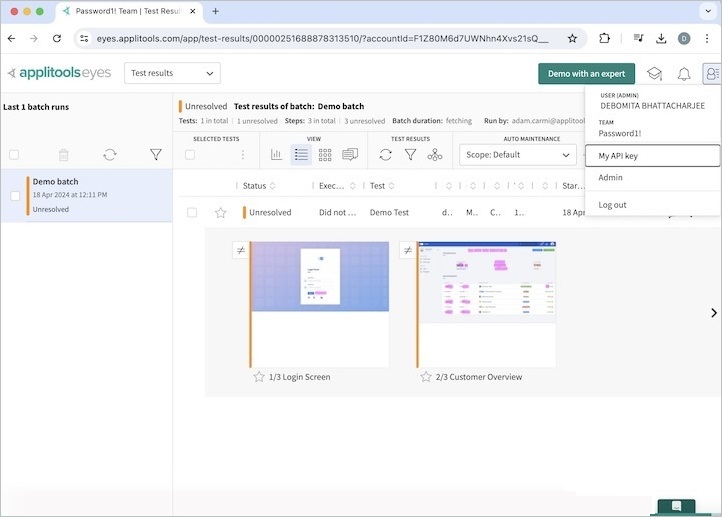
Step 8 − Click on the Applitools for Selenium IDE extension and paste the API Key copied in the Step 10. Then click on the Apply button.
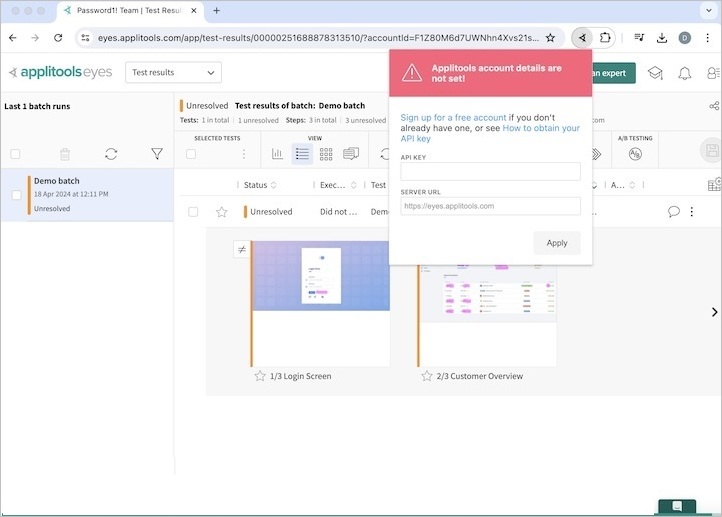
Step 9 − The message - Please open Selenium IDE should appear. Click on the Selenium IDE extension.
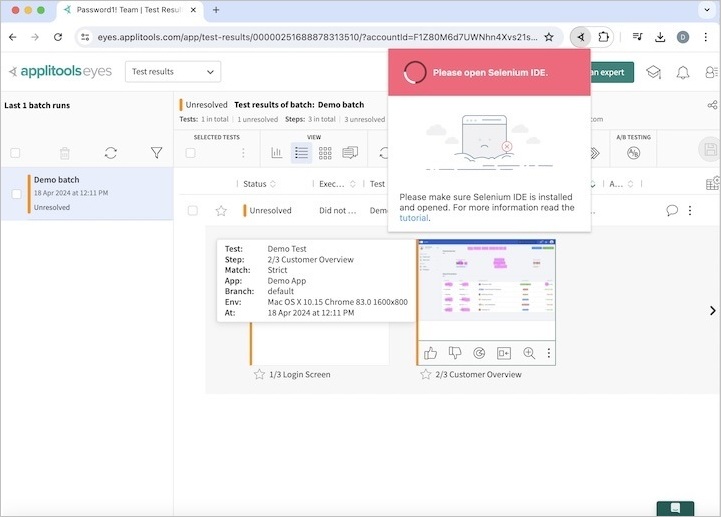
Step 10 − Click on the Create a new project link, then enter a project name, say Test12 under the Please provide a name for your new project. Finally, we would click on the OK button.
Step 11 − We would have the workspace ready in the Selenium IDE now. Check the Applitools for Selenium IDE eye commands for visual testing in Selenium IDE.
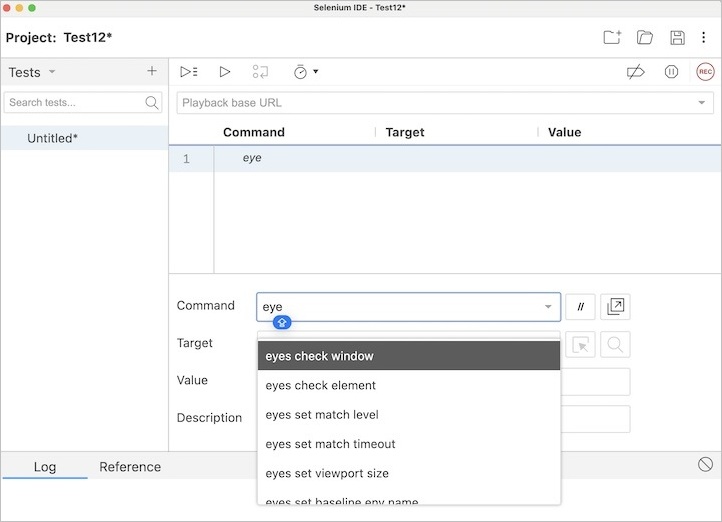
Step 12 − Let us take an example of the below page, click on the radio button beside the Yes label, then perform the visual testing of verifying the visual checkpoint of the complete window.
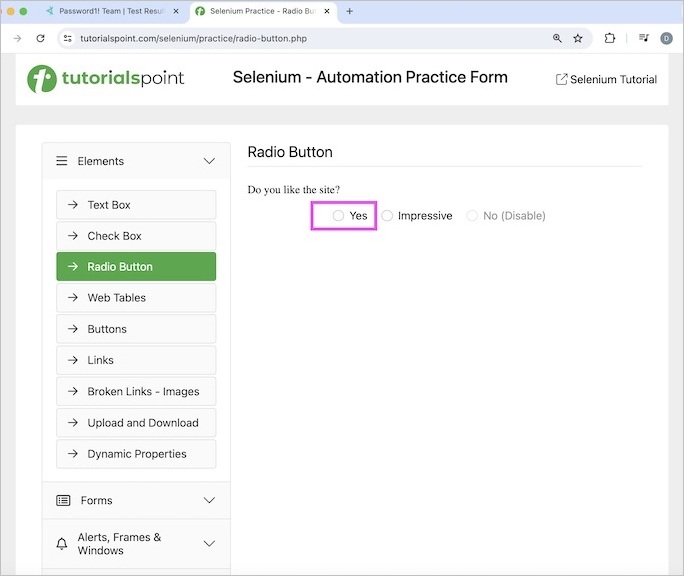
Step 13 − Enter open in the Command field, and Selenium Automation Practice Form in the Target field, to launch the application.
Step 14 − Enter click in the Command field, then enter xpath=/html/body/main/div/div/div[2]/form/div[1]/input in the Target field. Please note, /html/body/main/div/div/div[2]/form/div[1]/input is the xpath locator value of the radio button.
Step 15 − Enter the eyes check window in the Command field, and then enter Window Check in the Target field.
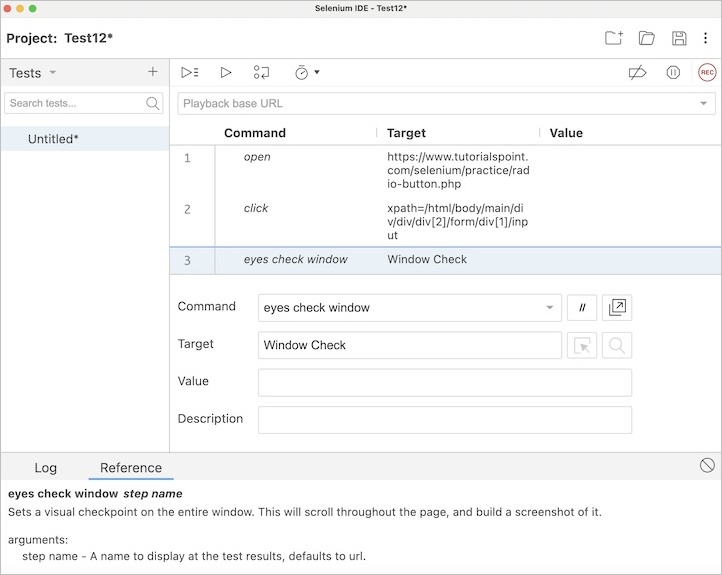
Step 16 − Run the test by clicking Run all tests from the top. The Log message - Preparing plugins for test run and the url to check the visual testing in Applitools should be displayed.
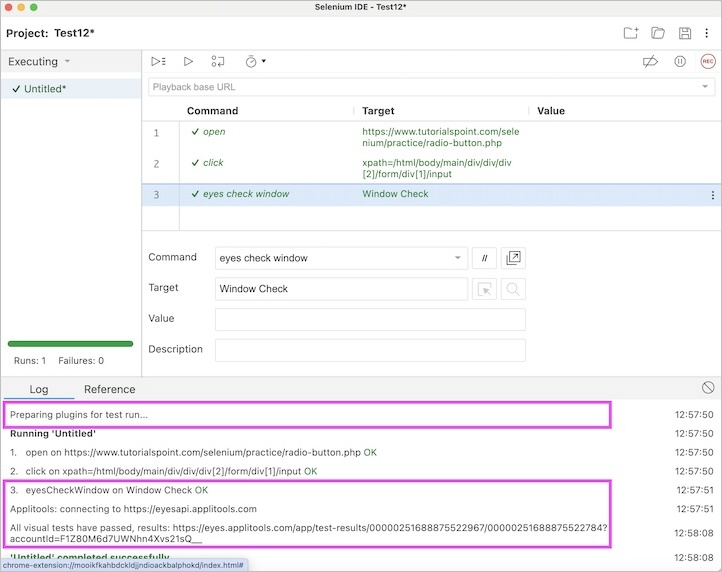
Step 17 − Click on the link displayed in the Log to view the visual testing resulting in the Applitools application.
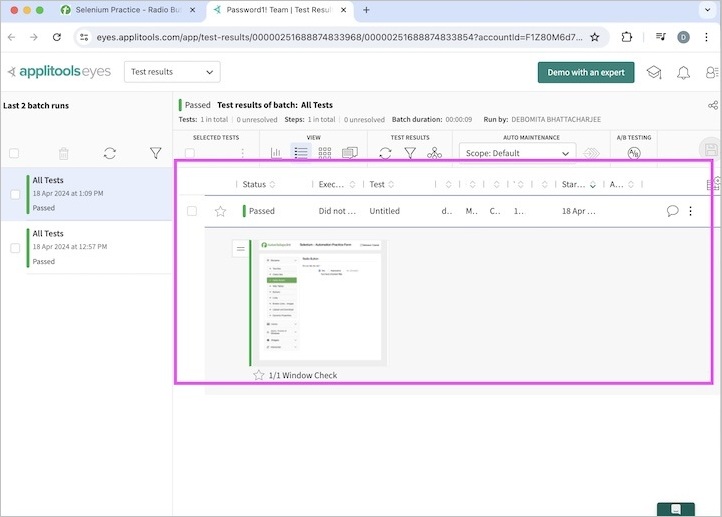
Step 18 − Click on the screenshot captured in the Applitools to get more details of the test like the date of execution, the resolution, platform, browser, and so on.
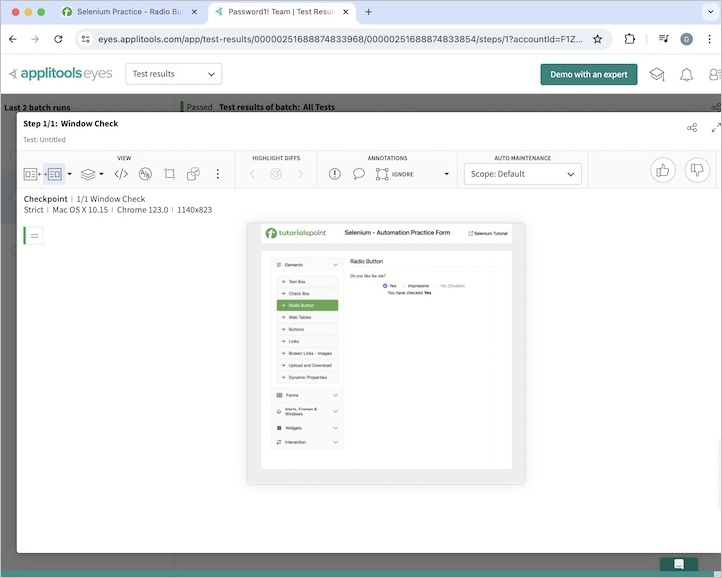
This test included both functional and visual automation testing steps and can be rerun several times to verify if the functionality and GUI of the application under test is working properly.
Conclusion
This concludes our comprehensive take on the tutorial on Selenium IDE Plugins. Weve started with describing some of the plugins used in Selenium IDE, and an example to walk through how to use the plugins with Selenium IDE. This equips you with in-depth knowledge of the plugins in Selenium IDE. It is wise to keep practicing what youve learned and exploring others relevant to Selenium to deepen your understanding and expand your horizons.